Breeding worms at home for fishing
For fishing, both artificial and natural types of bait are used. Regardless of the season and fishing method, the worm is as good as artificial bait. It is not always possible to buy the necessary worm in the store, and the price of such a purchase can be overpriced.
Breeding worms at home is not a very difficult task, it is enough to have the necessary information.
Breeding rules and features
Varieties and characteristics of worms:
The most popular in the field of worm breeding is the "prospector". This is a representative of one of the species of California red worms. Differs from fellows in a high level of productivity and fertility. He has a well-developed instinct for self-preservation. At low temperatures, the "prospector" dives to a safe depth. The temperature range for breeding is from +8 to +29 ° С. An adult is capable of producing about 1,500 worms per year. The worm is unpretentious in food, quickly gets used to another type of food. Resistant to many types of diseases.
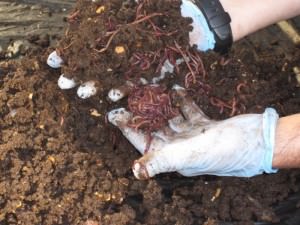
The California red worm is easy to grow at home. He is less fertile than his fellows. On average, 400 new individuals appear per year. An adult worm reaches 8 cm in length and weighs 1 g. Like a prospector, the main advantage is the speed of biomass production. The resulting vermicompost has saturated enzymes, the maximum amount of microelements and active substances. Comfortable conditions for the successful life of the red worm will be a temperature of 15-25 degrees and a relative humidity of the environment of 60%. In such conditions, he is able to live for about 16 years. The disadvantages of the Californian worm include picky in the choice of food, increased thermophilicity and the negative effects of direct sunlight.

The advantage of common earthworms is their good adaptation to the environment. This type of worm is considered a universal bait - more than a dozen different types of fish peck at it perfectly. The length of the grown worm reaches 15-30 cm, specimens that have reached 40 cm are often found. The main disadvantages are low life expectancy (up to 4 years), passivity in reproduction. Despite the shortcomings, earthworms are unpretentious in nutrition and have a fairly active growth.
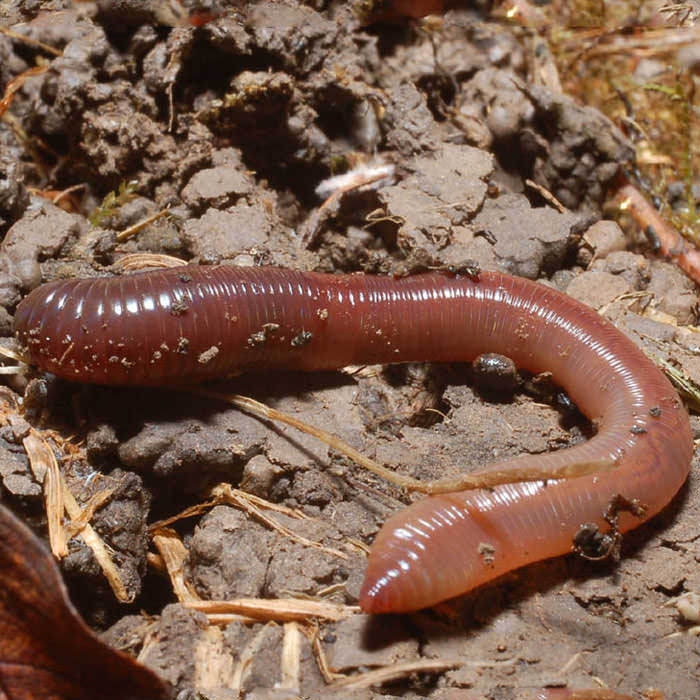
The mealworm is the larva of the beetle beetle. It tolerates temperature extremes and has a high reproduction rate at home. For development, a comfortable temperature is considered to be 28 degrees, while the humidity should not fall below 50%. They are not whimsical in the choice of food.

This worm is a favorite delicacy of many fish. The yellow liquid inside it has a specific smell that drives the fish crazy. These worms are similar in appearance to red ones. The difference lies in the conditions of detention. To create a habitat, you need: sawdust, manure, rotten hay or straw, black soil, wet leaves. All this is mixed and well pressed. The higher the soil pressure, the more comfortable it is for worms to live there. They have no preferences for temperature conditions and high humidity.
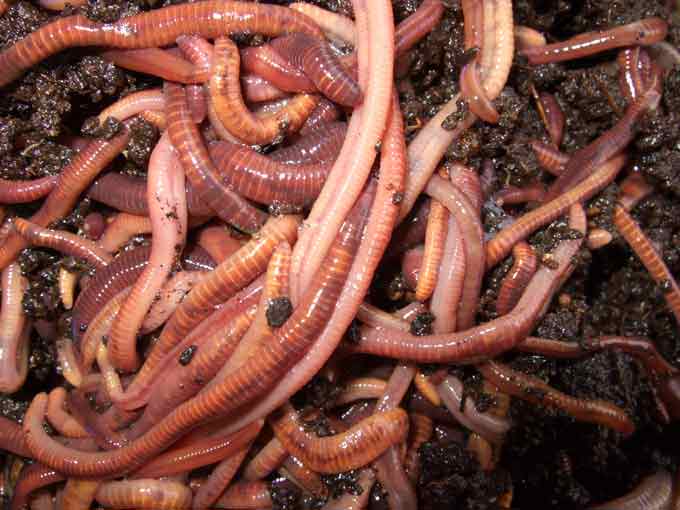
In the selection, there are also specially bred worms for fishing - This type of worm reproduces sluggishly, but it has a very fleshy body structure. Caring for them has certain difficulties associated with the constant maintenance of increased optimal living conditions.

Eating worms
The worms feed on rotten or dead plant debris. It is recommended to add to their diet cleaning from potatoes, stale bread, cabbage leaves, banana skin, kefir diluted with water, grass, rotting straw, remnants of used tea or coffee grounds, chicken droppings, manure, boiled vegetables.
It is forbidden to add the following ingredients to the food of worms:

- meat-containing waste;
- citrus peel;
- eggs;
- fermented milk products (the acidity of the environment increases);
- fresh manure (generates destructive heat up to 70 ° C).
Before serving food, it is well chopped in a meat grinder. The composition of the feed must be constant. When changing food, individuals must undergo adaptation over several weeks.
Putting a new portion of food is necessary 2-3 times a month. It all depends on the temperature regime - the warmer, the more often and more worms eat food. Remember, excess food ferments the soil, increasing its acidity.
Breeding worms
Worms are more commonly purchased from pet stores, the Internet, and fishing stores. When making a purchase, you should pay special attention to their appearance and general condition. They should be active and of a solid color.
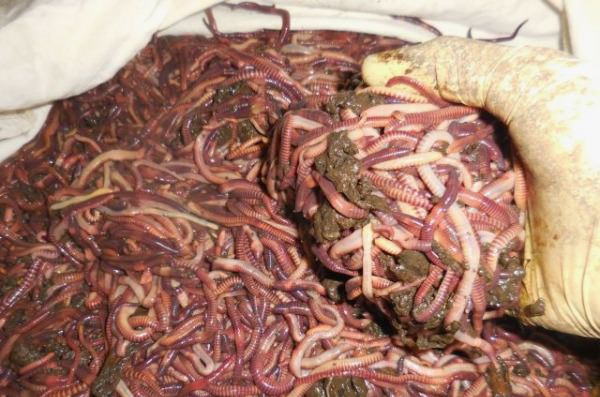
Settlement technology and rules for caring for worms
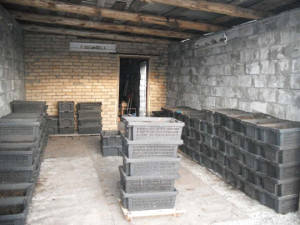
It is possible to breed worms not only in the village or in the country. Any place without noise and unnecessary vibration is suitable for this: in an apartment on a balcony or in a "dark" room, in a garage, in a garden or other utility room. The main condition is compliance with the optimal temperature regime and sufficient humidity (70%). Unpleasant odors can be avoided by sprinkling the feed with earth or vermicompost.
To breed worms at home, you need to buy a vermicomposter or make a do-it-yourself worm hole. This design is a plastic or wooden box (box), about 40cm high. Ventilation openings should be provided in the breeding container.
Holes are drilled in the top of the box or lid. The structure is installed at a slight slope in order to drain the worm tea formed during the life of the worms through the hole drilled in the bottom. An old refrigerator can act as a wormhole. It is placed with the doors up, drilling holes in advance.
If you do not want to make a wormhole, you can purchase a ready-made special product for growing worms - a vermicompost. It is made in the form of two plastic boxes installed one on top of the other. Both have ventilation holes and special slots on the bottom. A crane is mounted in the lower drawer, located on the legs. It is used to drain the resulting vermicelli.
After preparing the soil mixture, for 2-3 days a deepening is made in it and the first residents are settled in the wormhole. After that, the soil is evenly distributed and covered with a lid. We add food two days after the arrival.
To know the required level of soil acidity, we make a trial settlement in a smaller container. For breeding worms, the optimum acidity of the soil wash will fluctuate in the range of 6.6-7.7 rN. At higher acidity, the worms begin to die. Reduce its level by adding eggshells, chalk or limestone to the soil. To increase the acidity, sawdust, straw or plant remains are used.
If within a week the surface of the substrate is clean, and the worms are actively mobile, then the colonization was successful.
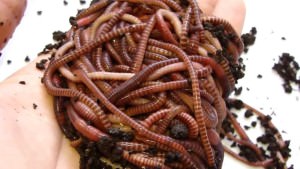
Feeding the worms is done every 1.5-2 weeks. The food is applied evenly over the entire surface of the box with a thickness of 5-7 cm. Under favorable conditions, worms multiply very quickly, therefore, it is necessary to have prepared wormholes for relocation in advance. Monitor the humidity at all times. The watering procedure is carried out with warm (room temperature + 24 ° C) water using a watering can with small holes.
With a substrate layer of more than 20 cm, loosening is necessary to enrich the soil with oxygen. Mixing is carried out with a special pitchfork or other tool with rounded ends. This procedure should be carried out twice a week.
As a result of the activity of worms, the soil, which is located in the box, is divided into three zones. The top layer contains nutrients. The layer in the middle is used by adults for housing. All products of their active processing are collected in the lower layer, which is why it is so important. This layer grows over time. After 3-4 months, the worms are transplanted into a new container, along with a small part of the substrate of the lower layer. And the process starts over.

Reproduction of worms
A new generation of worms emerge from cocoons. One female is able to lay only one cocoon per week. A month later, newborn worms appear. On average, 20 worms hatch from a cocoon. In two months, they grow to the size of an adult. During the year, the worm lays up to 24 cocoons. During the growth period, the worms are actively feeding, so they will have to feed more often.
Comfortable conditions for breeding: temperature in the range from +20 to +24 degrees, humidity 70%. It is desirable to keep different types of worms in separate boxes.
- It is better to cover the bottom of the box with a net, so it is more convenient to sift out vermicompost.
- You can keep earthworms and red worms together in one wormhole.
- Cow dung only becomes suitable for feeding after 6 months.
- The resulting vermicompost is effectively used for fertilizing strawberries, vegetables in the greenhouse and indoor plants.
- Some types of worms are used to obtain medicines.


